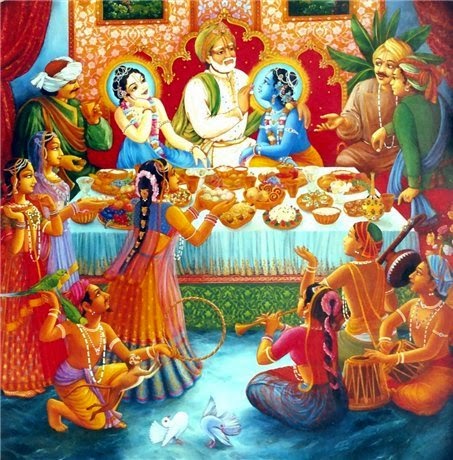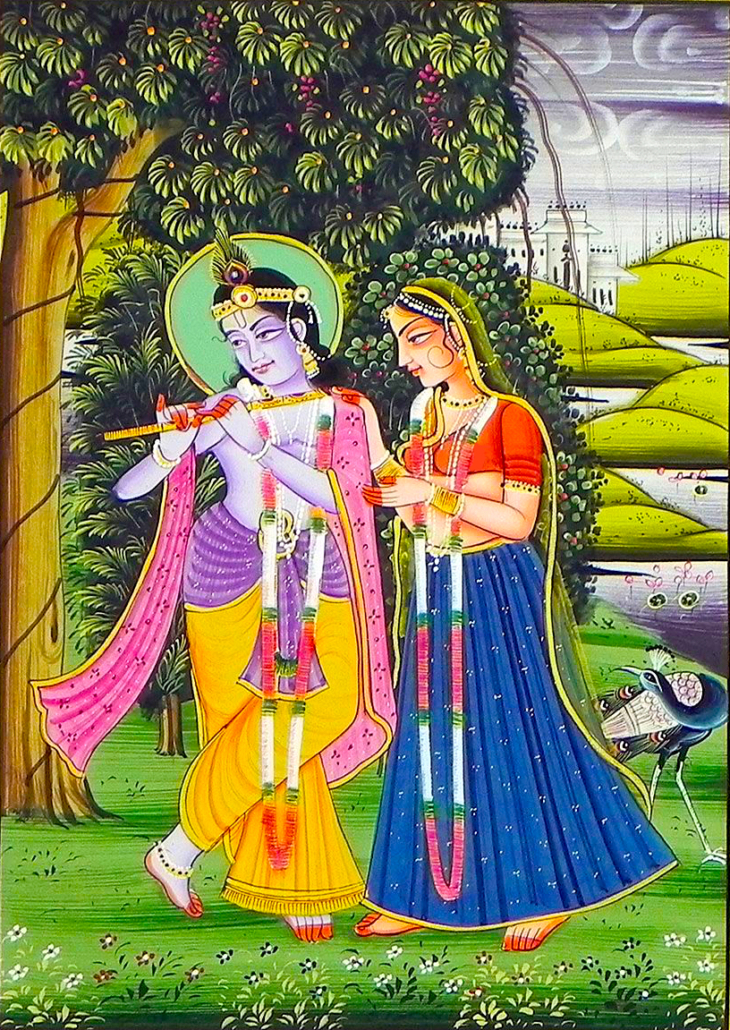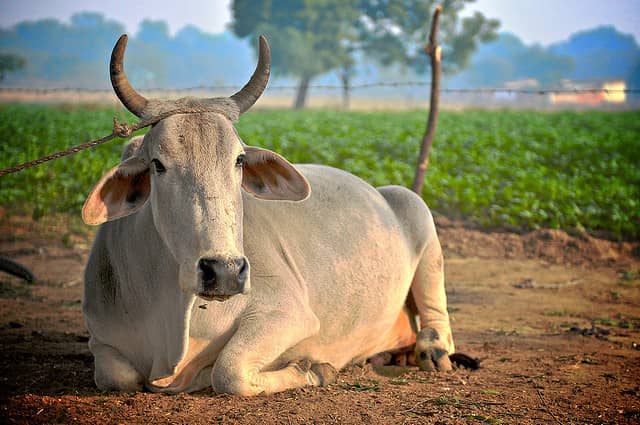Mahanidhi Madan Gopal Das
Krishna Frees Shakatasura
In Gokula, at the age of three months Krishna rolled over and crawled out of the bed. To commemorate the event Yasoda observed a special ceremony. The elderly gopis, looking like creepers of maternal affection, felt intoxicated with bliss by taking part in this function. It seems this pleasure came result of their previous piety. Since the gopis’ hearts overflowed with compassion, they always observed auspicious rituals for the satisfaction and protection of Krishna.
All the Vrajavasis anxiously rushed to see Krishna. The arrival of the splendidly dressed elderly gopis greatly enhanced the joyous atmosphere of the festival. Yasoda and other gopis smeared oil on Krishna’s body to celebrate the auspicious occasion of His leaving home for the first time to crawl about on His hands and knees. Mrdangas played melodiously while Yasoda bathed her son and honored the guests. Krishna-kumara looked extremely beautiful after His auspicious bath and the application of kajala to His lotus eyes.
Vrajesvari Yasoda pleased all her relatives by performing the traditional family rituals. Vrajaraja Nanda also relished boundless happiness during the festival. As an expert in domestic affairs, Rohini remembered her husband and distributed charity to all the guests. Afterwards, Yasoda put Krishna to rest on a soft mattress, which was whiter than powdered camphor, in an ornately decorated cradle, which she placed under a handcart. Mother Yasoda worshiped the guests while Krishna rested peacefully.
Melodious music from rumbling mrdangas, bherries, dundubhis and other instruments filled the air. The waves of music produced by the talented musicians sweetened all directions. Satisfied brahmanas recited Vedic hymns to bless the child. Yasodanandana, whose beauty defeats beauty personified, started crying due to hunger and a desire to drink Yasoda’s breast milk. But Vrajesvari could not hear Him due to the loud music and singing.
At this time, Krishna decided to kill Sakatasura, a demon who was hiding in the cart under which He lay. Opening His joyful eyes, Krishna simultaneously destroyed the cart and killed the demon by playfully kicking His feet. Without any effort Krishna vanquished that demon with His tender feet, which were unlimitedly beautiful and softer than the petals of a lotus flower. These were not the thunderbolt nails He used to kill Hiranyakasipu; nor were they the legs He extended throughout the universe in His Vamana incarnation.
The gentle tinkling of Krishna’s ankle-bells increased the splendour of His delicate little legs. Although the cart stood considerably higher than the child, Krishna easily kicked the wheel of the cart with His feet. The brass pots on the cart made a tremendously loud sound as they tumbled over the ground. From the force of Krishna’s kick the wheels split from the axle, the hubs and spokes fell apart, and the handcart collapsed. Everyone’s hearts stopped when they heard the shattering sound of Shakatasura falling down dead.
Thinking that Krishna may have been hurt, the Vrajavasis filled with anguish. Their hearts overwhelmed in fear, they anxiously rushed to the spot.With great anxiety they met Krishna and said, “Alas! Is this the beginning of some imminent danger? This cart represented auspiciousness since it remained in their house for so long without moving. How did this cart suddenly become inauspicious? This perfect boy is the sum total of all pious activities.
Although many heavy brass pots crashed down, hone of them touched the tender limbs of Krishna whose glossy body is smeared with musk. O Lord of Vrindavana, Nanda Maharaja! In any assembly you are the natural leader, and along with your wife Yasoda you are the embodiments of all fortune. Our words fail to describe the extent of your wonderful glories.” Thus the Vrajavasis praised the King of Vrindavana.
The cowherd boys met their parents and described the heroic deeds of Krishna in broken language. They said, “It is not His fault. Krishna felt hungry and started crying loudly for some milk. When He did not get any, then why blame Him if He did something wrong? You should not scold Krishna. Unless driven by the wind how can a lotus bud move, similarly, the cart broke and fell to the ground because Krishna kicked it with His legs while crying.” Assuming there must be some unknown cause, the elderly persons did not believe the statements of the children.
Fearing that the death of Sakatasura must have brought some danger to her son, Yasodarani fell down on the ground. Rohini and the gopis affectionately picked up Yasoda, and pacified her with the good news about Krishna’s safety. By their comforting words Yasoda regained her senses .and wiped away her tears.
Mother Yasoda said, “Alas! My three-month old baby, whose body is softer than butter, has suffered so much. Suddenly this cart broke and fell upon my son. Since my heart did not stop upon hearing about this, it must be harder than a thunderbolt. Shame on my motherly love! Alas! I am His mother in name only.
“The earth shook from the crashing of the cart and the people became speechless. When that cart fell down around my child He cried in fear but did not get hurt. I guess it must be the result of my misfortune. Otherwise, why are such evil events occurring like Putana’s visit and the breaking of the cart? Therefore the auspicious King of Vrindavana must arrange to prevent any further calamities coming to my child. From this incident I can only guess what further misfortune awaits me.”
Thus lamenting and feeling apprehensive, Mother Yasoda ran quickly to her son. She saw Krishna’s attractive face conquering the effulgent beauty of the moon with its ever-increasing charm. Yasoda drowned in an ocean of sweetness when she placed Krishna on her lap. Surcharged with feelings of bliss, Yasoda’s mind became pacified and free from worry.Nanda and Yasoda observed an auspicious religious ritual on behalf of Krishna-kumara, whose radiant body looked gorgeous.
Although Krishna is the Supreme Brahman, He appeared in Vrindavana as a boy with curly dark bluish black hair and a tender transcendental form. As Yasoda fondly fed Krishna the milk dripping from her breasts, He gradually fell asleep. Then she tucked Krishna back in His bed under the cart just as before. Rohini, the wife of Vasudeva, whose lustrous beauty surpasses all the women of heaven, engaged the brahmanas in chanting auspicious mantras to counteract the evil effects caused by Shakatasura.
Krishna Frees Trnavarta
One blissful day during Krishna’s first year, Yasoda lifted up her resplendent, jewel-like son while passing through the main chamber of the palace. She lovingly fondled and caressed Him. With His perfect intelligence Krishna immediately perceived some danger. Employing His Yogamaya potency, Krishna decided to reveal an ecstatic childhood pastime to show compassion to those rotting in the material world.
Thinking thus, Krishna made His body so heavy that He forced His mother to set Him down. Mother Yasoda, who is worshipable by all the three worlds, suddenly felt very tired from carrying her heavy son. As a creeper hangs down from the weight of ripened fruits, similarly, mother Yasoda bent over from the heavy weight of her maternal affection. Afraid of dropping her beloved son, Yasoda carefully sat Krishna down.
By the sweet will of the Lord, Yogamaya influenced Yasoda’s mind. Without the slightest worry, She left Krishna alone outside the house and went inside to perform other domestic duties. Mother Yasoda had no idea that she had left Krishna in a dangerous position. Yasoda’s bewilderment had no other apparent cause than the all-powerful manifestation of her son’s majesty. Realizing her mistake upon entering the house, Yasoda ran back to get Krishna.
Meanwhile a demon named Trnavarta descended upon Vrindavana. Taking the form of a huge cyclone, he terrorized all the people and animals. The whirlwind created by the demon seemed like a blacksmith’s bellows emitting a loud sound in all directions. Trnavartacovered all of Vrindavana in a dense cloud of darkness.
Trnavarta was one extremely powerful demon sent by Kamsa, whose very presence disturbed the natural balance of the material world made of five gross elements. He converted the three worlds into one element, namely wind. At its zenith it was so dense that it blinded everyone on earth.
Intent on killing Krishna, Trnavarta quickly attacked Him with his powerful winds. He dropped a deadly shower of dust, grass, and broken pots on the people of Vrindavana. Mother Yasoda worried about her son’s safety. She did not realize that her darling son, whose soft hands and feet possess the beauty, fragrance, and coolness of a lotus flower, could easily kill the biggest giants or the immortal demigods in heaven.
Suddenly Trnavarta kidnapped that tender baby who would soon cause his death. But Krishna did not feel the slightest pain or distress. The whirlwind sent the sweet fragrance of Krishna’s body into the celestial abodes. Krishna happily assumed a powerful feature while contemplating how to kill the demon. Trnavarta felt that he was carrying a fire bound in a cloth, a deadly poison within his throat, or death personified.
To satisfy the celestial damsels desirous of His darsana, Krishna rode the whirlwind into the heavens. When Krishna struck the demon with His hand, which smelled like musk and looked as splendid as the stem of a lotus, the demon’s life air slowly left his body. Then with a final blow Krishna crushed the demon to dust.
Krishna looked like a blue sapphire locket hanging from the demon’s throat. When they crashed on the ground the demon died, but Krishna landed safely on the earth. Seeing this amazing feat, the Vrajavasis filled with joy. Though appeared as a mere baby, Krishna sometimes proved His by displaying His unlimited potency. That great whirlwind demon, who showered dust, rain and clumps of earth all over Vrindavana, touched Krishna’s body, and by that attained the supreme fortune of becoming eligible for liberation.
Thus Trnavarta did the best possible act to purify his family line. When Yasoda could not find her son after the cessation of the storm, her heart turned into a desert of lamentation. At that time, she lost all patience, and unconsciousness personified appeared as her only companion. Feeling helpless and overwhelmed, Mother Yasoda collapsed on the earth. Though suffering immensely, Yasoda’s faint breathing indicated that she still lived.
Understanding her intense pain of lamentation, the Vrajavasis tried to revive Yasoda by sprinkling water on her face and speaking comforting words. They said, “O pious and learned lady! The extent of your good fortune is unlimited. Your son gives happiness to the eyes of everyone. . The honey-sweet dealings of Krishna-kumara continually increase our attachment to Him. Due to your purity your son is still alive.
“O King and Queen of Vrindavana! Now we realize that all your fortune and prestige is caused by your illustrious son. Ma Yasoda! Although you are apprehensive about your son’s safety, you can give up your distress, for the illusion has left our village. Do not let your mind burn any longer. Lift up your son and rejoice.”
Thus reassured, Yasoda regained consciousness, but she was still in anxiety. She said, “Just a few minutes ago I could not tolerate the weight of my son so I put Him down, and then that demon captured Him. Can you explain how a tiny baby can suddenly become so heavy that even his mother cannot carry him? I guess this must be due to my bad luck. Alas! How could my son, who is as soft as butter and cannot even tolerate the pain of my lap, endure the tremendous pain generated by that demon who attacked Vrindavana with a shower of grass, high winds, and pieces of bricks?
“Previously Providence protected my son from the poisonous breasts of Putana and the falling cart demon. Now I pray to Him to always protect my beloved son. Alas! I got my son back because of the Narayana’s protection. From now on I will never take Him off my lap and put Him on the ground. Quickly help me find my son. Where is He? Has the wind demon snatched Him and carried Him away? As long as I live I will never again leave Him outside alone.”**
Saying this,Yasoda fell down unconscious. Sympathizing with the plight of Yasoda, the elderly gopis again tried to pacify her. Due to the burning fire of lamentation, Yasoda’s lotus face looked morose and took on the hue of a red lotus. Her sadness submerged the Vrajavasis in an ocean of distress.On the outskirts of the village, where He had previously played upon the breast of Putana, Krishna-kumara triumphed over His enemy by smashing him on the earth. This location brought success, just as victory is assured for one choosing a favorable constellation before fighting.
******
While vanquishing that demon, Krishna, the greatest of all relishers, looked like a blossoming aparajita flower amidst a garden of thorns, or a blue lotus rising above a lake choked with tall reeds, or a small shining lamp atop a dense cloud of darkness. Krishna stood as the embodiment of transcendental knowledge amidst an ocean of ignorance. He resembled a river of nectar flowing in a desert, or a flower of personified bliss atop of a tree of misery.
Seeing the beautiful blue baby in a safe position, the crowds gradually dispersed. One person commented, “This low-class, faithless demon has kept the demigods from blessing us with their association. Taking the form of a whirlwind, he prevented all auspicious acts and tortured Mother Earth. Finally he destroyed himself by the reaction of his heinous sin of attempting to kidnap the Prince of Vrindavana. Since he did even have enough piety to approach Krishna’s house, he died outside of town instead.”
Someone else said, “O look at this boy! He is the eternal
Parambrahma and the Supreme Personality of Godhead! The effulgence of His unlimited opulence is always expanding. He is an invincible razor sharp sword annihilating the asuric kings with His awesome power. From the very beginning, Krishna established the glories of His name by killing the Putana demon. It is He who freed everyone from distress by destroying Sakatasura. He also demolished that demon who terrorized the three worlds.”
Another Vrajavasi said, “Like King Indra, Nanda Maharaja must have performed severe austerities and done many good deeds to accrue such vast piety. As a result, Nanda Baba received a boon that enabled his son to defeat formidable asuras like Putana and others. There is no other way to explain how all these demons met their death.”
Having accepted Krishna as the wealth of their lives, the Vrajavasis rejoiced upon finding Him free from danger. Picking Him up in their loving arms, they carried Krishna into Yasoda’s inner chambers. The atmosphere filled with the happy news of Krishna’s well-being. Witnessing the pleasure of the Vrajavasis also brought waves of bliss to the mind of Asurari, Krishna, the destroyer of demons.
Observing this joyful pastime of Krishna, the elderly gopis. smiled and said, “Hey Bhagavati! You are worshipable by everyone in the world. Due to your good fortune your son is now safe and happy.” Such reassuring words greatly pleased the mind of Yasoda. When rain clouds forcefully pour water on a burned out forest, a fresh abundance of life reappears to beautify that forest with elegance and contentment. In a similar way, Yasoda looked refreshed and beautiful upon regaining her beloved son.
Though happy, Yasoda felt somewhat anxious and confused by the unusual event. In this state of bewilderment she said, “Where is He? Where is He?” Compassionately taking charge of Yasoda, the Vrajavasis gradually nursed her back to consciousness. At that time Yasoda’s eyes looked like a pair of lotus flowers moistened with cool drops of dew. Her name, fame, and position surpass everyone in creation. Waking from her trance, Yasoda stood up and drowned in an ocean of joy upon beholding her all-attractive son.
Other ladies glorified Krishna-kumara, “Hey Krishna! Hey Krishna!” A dying man receives new life by taking sanjivam rasa. Similarly, Yasoda, who nearly died in separation, revived upon meeting her dearest son Krishna. She felt she had retrieved an invaluable lost treasure. Sitting Krishna on her lap, she lovingly gazed at Him with unblinking eyes. But being only semi-conscious, Yasoda could not relish the full bliss of Krishna’s direct association.
As her sleeping senses awoke in the service of her beloved son, she said, “O darling! From the time of Your birth You have caused so much trouble to Your mother. Of course, this is not Your fault, so how can J blame You? I am the one who left You outside and unprotected. This shows my heart is as dry as wood, and therefore I qualify as Your mother in name only. But since I am known as Your mother, You have never treated me cruelly.
“Although that demon kidnapped You, because You of Your innocence You somehow escaped and returned. O my beloved! Your love for me is unprecedented and transcendental. I should be punished for my grave mistake.”
Out of intense motherly affection, Mother Yasoda suckled Krishna with her breast milk and put Him to rest. Although appearing in a human form to act as the son of Yasoda, Krishna-kumara eternally exists as the personification of transcendental bliss.
Kaviraja Sri Karnapura Goswami’s AnandaVrindavanaCampuki jai!
Radha-GovindaVraja Lilas ki jai! Jai Jai Sri Radhe!
All parts of Krishna Nectar Lilas can be found here.



